Michael J. Behe's Blog, page 184
July 3, 2021
What exactly is National Center for Science Education doing these days?
Readers will remember NCSE as the Darwin in the Schools lobby. Currently hallooing about climate change as well as evolution if you go by their current website:
“National surveys show that 40% to 60% of U.S. public school science teachers hedge, equivocate, or send a mixed message when they teach evolution or climate change. NCSE aims to help all of them improve their teaching practices.”
Also:
“NCSE vigilantly monitors efforts to interfere with the accurate teaching of climate change and evolution and strategically mobilizes local communities and educators to respond effectively when problems arise.”
So even if every U prof was questioning Darwinism (and that will happen, the way things are going), nobody who works in the U.S. tax-funded school system is allowed to.
Nice gig.
Copyright © 2021 Uncommon Descent . This Feed is for personal non-commercial use only. If you are not reading this material in your news aggregator, the site you are looking at is guilty of copyright infringement UNLESS EXPLICIT PERMISSION OTHERWISE HAS BEEN GIVEN. Please contact legal@uncommondescent.com so we can take legal action immediately.Plugin by Taragana
No hope for life on Venus but maybe Jupiter now…
“When we looked at the effective concentration of water molecules in those clouds, we found that it was a hundred times too low for even the most resilient Earth organisms to survive.” John Hallsworth, a microbiologist at Queen’s University in Belfast, U.K., and lead author of the paper, said in a news conference on Thursday (June 24). “That’s an unbridgeable distance.”
The findings are likely a disappointment for the Venus research community, which was invigorated last September by the discovery of phosphine, a compound made of atoms of phosphorus and hydrogen that on Earth can be associated with living organisms, in Venus’ atmosphere. At that time, researchers suggested the phosphines may be produced by microorganisms residing in those clouds.
Teresa Pultarova, “No hope for life in Venus clouds, but maybe on Jupiter, study suggests” at Space.com
Phosphine? Okay, here: Sabine Hossenfelder asks, whatever happened to life on Venus?
Meanwhile,
However, the researchers looked at data from other planets too and found that the clouds of Jupiter do provide sufficient water activity to theoretically support life. Data collected by the Galileo probe at altitudes between 26 and 42 miles (42 and 68 kilometers) above the surface of the gas giant suggest the water activity value to sit at 0.585, just above the survivable threshold. Temperatures in this region are also just about survivable, at around minus 40 degrees F.
Teresa Pultarova, “No hope for life in Venus clouds, but maybe on Jupiter, study suggests” at Space.com
If we could only just find one surviving life form — even if it came from Earth.
Copyright © 2021 Uncommon Descent . This Feed is for personal non-commercial use only. If you are not reading this material in your news aggregator, the site you are looking at is guilty of copyright infringement UNLESS EXPLICIT PERMISSION OTHERWISE HAS BEEN GIVEN. Please contact legal@uncommondescent.com so we can take legal action immediately.Plugin by Taragana
From Bartlett Publishing, New Book: Apes as ancestors
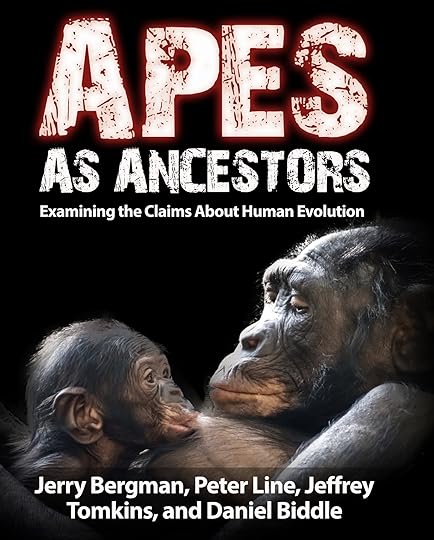
What do we really know about it as opposed to what we are commanded by school systems to believe?: Here are some arguments against that view.
Copyright © 2021 Uncommon Descent . This Feed is for personal non-commercial use only. If you are not reading this material in your news aggregator, the site you are looking at is guilty of copyright infringement UNLESS EXPLICIT PERMISSION OTHERWISE HAS BEEN GIVEN. Please contact legal@uncommondescent.com so we can take legal action immediately.Human ancestry is especially important because it tells us about ourselves. You have probably heard of various putative human ancestors in the news. Ardipithecus, Australopithecus, Homo habilis, “Lucy,” etc. Here is your opportunity to go beyond the media reports and the summaries and see what was really found and what it really tells us. Which ones are actually our ancestors? Which ones are mistaken? Which ones can really be considered human? In Apes as Ancestors, four scholars take a detailed look at the fossil evidence, including numerous photos taken by the authors themselves. They describe the fossils, where they found them, what others have to say about them, and what can be realistically and reliably determined from the fossils. They focus on the evidence – what does it actually tell us? The results may surprise you.
Jerry Bergman, Peter Line, Jeffrey Tomkins, and Daniel Biddle, “Apes as Ancestors” at Bartlett Publishing
Plugin by Taragana
July 2, 2021
An engineering perspective on the bacterial flagellum
A new paper at Bio-Complexity:
Copyright © 2021 Uncommon Descent . This Feed is for personal non-commercial use only. If you are not reading this material in your news aggregator, the site you are looking at is guilty of copyright infringement UNLESS EXPLICIT PERMISSION OTHERWISE HAS BEEN GIVEN. Please contact legal@uncommondescent.com so we can take legal action immediately.This study examines the bacterial flagellum from an engineering viewpoint. This examination concentrates on the structure, proteins, control, and assembly of a typical flagellum, which is the organelle imparting motility to common bacteria. Two very different, independent approaches are applied and then compared in three separate papers: Parts 1, 2, and 3. The first approach is a constructive or top-down approach, covered in this Part 1. It considers the purpose of a bacterial motility system, its typical environment, new and existing required resources, and its physiology. It sets forth the logically necessary functional requirements, constraints, assembly, and relationships. The functionality includes a motility control subsystem and provision for self-assembly. The specification of these requirements is intended to be independent from knowledge of the flagellar structures. This is original material not covered in academic papers on the flagellum. Part 2 will cover the second approach, an analytical or bottom-up approach. It will document the known 40+ protein components and the structure, assembly, and control of a typical flagellum. The bacterial flagellum is a well-researched molecular subsystem. However, in Part 2 the assembly relationships will be illustrated graphically in a form and detail not found in previous literature. Part 3 will compare the two approaches and conclude with several original observations. Those include the coherent assembly orchestration and an ontology of the exceedingly specific protein-binding properties. The latter observation is significant, and it suggests future modeling to elucidate how the strong, coherent, multi-way protein binding is achieved at the molecular level. Paper.
Waldean A Schulz, “An Engineering Perspective on the Bacterial Flagellum” at Bio-Complexity
Plugin by Taragana
Can information be used as a form of energy?
Well, here’s one effort:
Significance: Around 100 y ago, Szilard imagined how to raise a weight without doing any work, just using the information gained by “looking” at a single gas molecule bouncing inside a box. Here, we designed an engine that stores energy by raising a bead against gravity, driven purely by information about the bead position. No work is done directly on the bead; instead, all dissipation occurs in the measuring apparatus. By choosing the right size of bead and through careful design, we improved information-engine performance by more than a factor of 10 over the best previous designs. We achieve a maximum velocity of 190 μm/s and maximum power of 103 kBT/s, numbers comparable to those measured in microorganisms.
The information engine designed by SFU researchers consists of a microscopic particle immersed in water and attached to a spring which, itself, is fixed to a movable stage.
Researchers then observe the particle bouncing up and down due to thermal motion.
“When we see an upward bounce, we move the stage up in response,” explains lead author and PhD student Tushar Saha. “When we see a downward bounce, we wait. This ends up lifting the entire system using only information about the particle’s position.”
Repeating this procedure, they raise the particle “a great height, and thus store a significant amount of gravitational energy,” without having to directly pull on the particle.
Saha further explains that, “in the lab, we implement this engine with an instrument known as an optical trap, which uses a laser to create a force on the particle that mimics that of the spring and stage.”
Joseph Lucero, a Master of Science student adds, “in our theoretical analysis, we find an interesting trade-off between the particle mass and the average time for the particle to bounce up. While heavier particles can store more gravitational energy, they generally also take longer to move up.”
“Guided by this insight, we picked the particle mass and other engine properties to maximize how fast the engine extracts energy, outperforming previous designs and achieving power comparable to molecular machinery in living cells, and speeds comparable to fast-swimming bacteria,” says postdoctoral fellow
Jannik Ehrich. University Communications, “World’s fastest information-fuelled engine designed by SFU researchers” at Simon Fraser University (May 11, 2021) The paper is closed access.
Hat tip: Philip Cunningham
Copyright © 2021 Uncommon Descent . This Feed is for personal non-commercial use only. If you are not reading this material in your news aggregator, the site you are looking at is guilty of copyright infringement UNLESS EXPLICIT PERMISSION OTHERWISE HAS BEEN GIVEN. Please contact legal@uncommondescent.com so we can take legal action immediately.Plugin by Taragana
From Eric Holloway: COVID-19’s Origins: Uses and Misuses of the Explanatory Filter
From all the misuse, you might think the explanatory filter is useless. Maybe it cannot tell us anything about the lab theory. Would you be surprised to know that scientists close to Dr. Anthony Fauci used the explanatory filter to textbook perfection right at the beginning of the pandemic?
According to emails obtained from Dr. Fauci, a scientist named Dr. Kristian Andersen followed the explanatory filter correctly to initially arrive at a design inference regarding the virus’ origin. Quoting from the article:
In an email to Dr. Fauci sent on January 31 last year, Kristian G. Andersen of the Scripps Research Institute told the National Institute of Allergy and Infectious Diseases director that some of SARS-CoV-2’s features “(potentially) look engineered.”
… “I should mention that after discussions earlier today, Eddie, Bob, Mike, and myself all find the genome inconsistent with expectations from evolutionary theory,” the expert added. “But we have to look at this much more closely and there are still further analyses to be done, so those opinions could still change.”
James Walker, “Fauci Emails Show Experts Had Concern Covid Virus Could ‘Look Engineered’” At Newsweek
In a New York Times interview Dr. Andersen expands on what he meant by “inconsistent” with evolutionary theory …
Eric Holloway, “How a critic of intelligent design theory misunderstands the application of design inference” at Mind Matters News
Takehome: Would you be surprised to know that scientists close to Dr. Fauci used the explanatory filter to textbook perfection right at the beginning of the pandemic?
Copyright © 2021 Uncommon Descent . This Feed is for personal non-commercial use only. If you are not reading this material in your news aggregator, the site you are looking at is guilty of copyright infringement UNLESS EXPLICIT PERMISSION OTHERWISE HAS BEEN GIVEN. Please contact legal@uncommondescent.com so we can take legal action immediately.Plugin by Taragana
Well some life forms, it turns out, benefited from the COVID-19 pandemic
Couldn’t resist starting today’s news with this one:
One of those life forms was one you might not have expected to benefit, particularly:
After SARS-CoV-2 was found to be spreading in the US early in 2020, local governments issued shelter-in-place orders to try to combat the virus. Around Santa Cruz, California, this resulted in a 50 percent reduction in local travel, according to a paper published June 23 in Current Biology. Local mountain lions, which typically steer clear of human-populated areas, took notice, expanding their ranges closer to urban areas, the study found.
Jef Akst, “Pandemic Lockdown Eases Mountain Lions’ Fear of Urban Areas” at The Scientist The paper is open access.
This is a cougar on Vancouver Island off the coast of North America, where your UD news is produced:
Please also enjoy Snagglepuss, a North American cougar (animated cartoon) with all the virtues (sorry, faults) of a feline:
Sorry if Snagglepuss gets Canceled later, like PePe LePew. We all hate that crap too.
Copyright © 2021 Uncommon Descent . This Feed is for personal non-commercial use only. If you are not reading this material in your news aggregator, the site you are looking at is guilty of copyright infringement UNLESS EXPLICIT PERMISSION OTHERWISE HAS BEEN GIVEN. Please contact legal@uncommondescent.com so we can take legal action immediately.Plugin by Taragana
Haeckel’s biased, manipulative, dishonest drawings
It is strange that Haeckel has come up again, so let us first understand just how manipulative and dishonest he was in his books that popularised Evolutionism in Germany and elsewhere. As a start, here is his infamous drawing of heads of men and other primates:
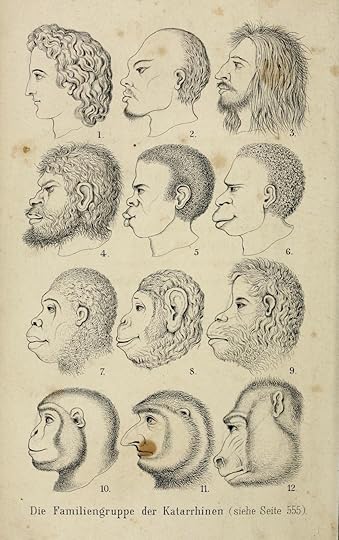
This was a time when photography was not ubiquitous, where trips to Zoos and Museums were relatively rare and so “heavy artillery” “facts” in drawings like this from respected scientists, scholars and publishers would have powerful impact.
I just say, failed duty to truth, right reason, prudence [including warrant] and fairness. Likely, though, Haeckel did not see where this sort of racist propaganda would end, in the 1930’s and 40’s.
It is in this context that we should evaluate his similarly artfully distorted comparative illustrations of embryos, intended to support the phrase — he seems to have coined it — ontogeny recapitulates phylogeny . . . the development from zygote retraces evolutionary, body plan level ancestry. (Often, in textbooks up to the turn of the 2,000’s, much was made of what superficially looks like gill filaments.)
Here, the 1874 version (the first was 1868):
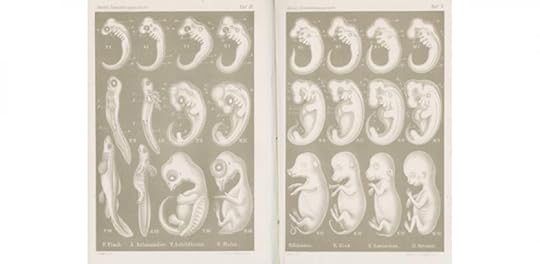
Richardson’s comparison [HT: Creation dot com}:
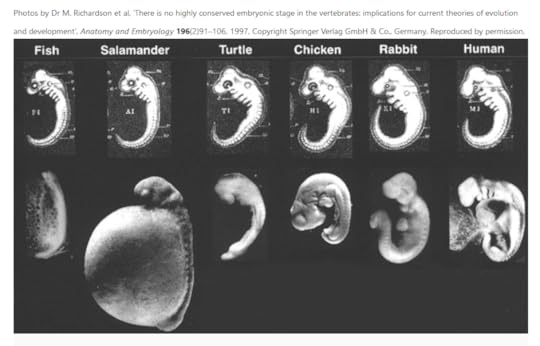
In Jonathan Wells’ Survival of the Fakest, he documents the gill slits distortion, c 2000, from a textbook by a well known publisher:
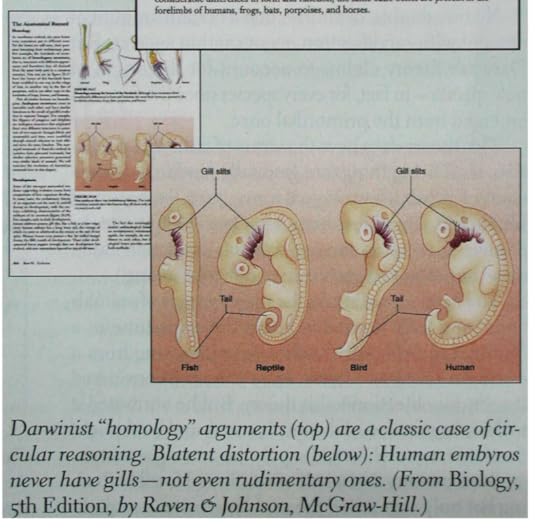
If memory serves, gill slits was in my HS Bio textbook and was shown in TV documentaries from about 25 – 30 years earlier.
Wells’ commentary is, for cause, stinging:
Darwin thought “by far the strongest single class
of facts in favor of” his theory came from embry-
ology. Darwin was not an embryologist, however,
so he relied on the work of German biologist Ernst
Haeckel, who produced drawings of embryos from
various classes of vertebrates to show that they are
virtually identical in their earliest stages, and become
noticeably different only as they develop. It was this
pattern that Darwin found so convincing.
This may be the most egregious of distor-
tions, since biologists have known for over a cen-
tury that vertebrate embryos never look as similar as
Haeckel drew them. In some cases, Haeckel used
the same woodcut to print embryos that were sup-
posedly from different classes. In others, he doc-
tored his drawings to make the embryos appear
more alike than they really were. Haeckel’s con-
temporaries repeatedly criticized him for these mis-
representations, and charges of fraud abounded in
his lifetime. In 1997, British embryologist Michael
Richardson and an international team of experts
compared Haeckel’s drawings with photographs of
actual vertebrate embryos, demonstrating conclu-
sively that the drawings misrepresent the truth.
The drawings are misleading in another way.
Darwin based his inference of common ancestry on
the belief that the earliest stages of embryo devel-
opment are the most similar. Haeckel’s drawings,
however, entirely omit the earliest stages, which are
much different, and start at a more similar midway
point. Embryologist William Ballard wrote in 1976
that it is “only by semantic tricks and subjective
selection of evidence,” by “bending the facts of
nature,” that one can argue that the early stages of
vertebrates “are more alike than their adults.”
Yet some version of Haeckel’s drawings can
be found in most current biology textbooks. Ste-
phen Jay Gould, one of evolutionary theory’s most
vocal proponents, recently wrote that we should be
“astonished and ashamed by the century of mind-
less recycling that has led to the persistence of these
drawings in a large number, if not a majority, of
modern textbooks.”
This contains a reference to the embryological hourglass issue:
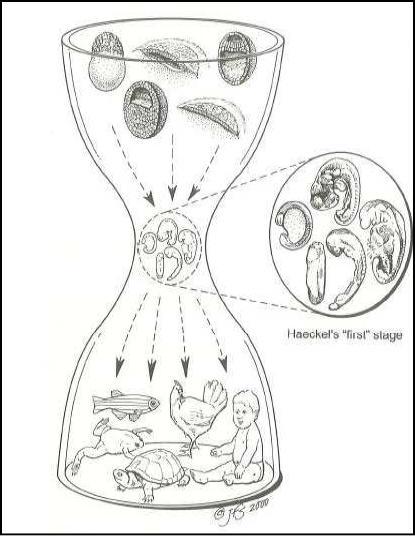
That is, some accept that there is a bottleneck stage but it is not the initial one nor is there strong commonality leading up to it before onward divergence to the fully formed newborn or newly hatched.
We do not need to go into an extensive debate with revisionist side tracks that minimise the significance of Wells’ work to bring the icons issue to public attention, Haeckel’s frauds and/or distortions were important and up to a few years ago had lingering impact. END
Copyright © 2021 Uncommon Descent . This Feed is for personal non-commercial use only. If you are not reading this material in your news aggregator, the site you are looking at is guilty of copyright infringement UNLESS EXPLICIT PERMISSION OTHERWISE HAS BEEN GIVEN. Please contact legal@uncommondescent.com so we can take legal action immediately.Plugin by Taragana
July 1, 2021
At Evolution News: What do biologists really know about macroevolution?
Surprisingly little, if we leave out banging lecterns and ending people’s careers. That’s becoming clearer:
A recent paper in Science allows us to hold the magnifying glass up to claims of observable evidence supporting macroevolution. Gustavo Burin et al., in “Macroevolutionary stability predicts interaction patterns of species in seed dispersal networks,” published in the journal Science, use the word macroevolution 32 times. Burin and two colleagues from Brazil studied 468 bird species in 29 seed dispersal networks. From the data, they claimed to see evidence for macroevolution — evidence so secure, it allows them to make predictions about evolution. This should be a good case study. Do they really know about evolution, or is their exercise a detailed construction of a house of cards?
Two reviewers, Carolina Bello from Switzerland and Elisa Barreto from Brazil, gave their perspective about the paper, also in Science. As evolutionists, they were pleased to see the effort by Burin’s team showing “The footprint of evolution in seed dispersal interactions.” …
After reading the Burin paper, therefore, Bello and Barreto are not entirely sure the authors know what they claim to know.
One thing Darwinism has going for it: it sure generates a lot of busy work. But so does constructing a house of cards; whether effort corresponds to knowledge is a separate question. With their 32 mentions of macroevolution, can Burin’s team demonstrate knowledge about it? Even in the case of watching birds eat fruit, is the evidence clear? The authors are offered a fair chance to convince a skeptic as we dive into the text and supplemental materials.
Evolution News and Science Today, “What Do Biologists Really Know About Macroevolution?” at Evolution News and Science Today (June 23, 2021)
And “Colin Patterson’s question echoes through the decades: “Can you tell me anything you know about evolution, any one thing, any one thing, that is true?”
It should be okay not to be sure.
Copyright © 2021 Uncommon Descent . This Feed is for personal non-commercial use only. If you are not reading this material in your news aggregator, the site you are looking at is guilty of copyright infringement UNLESS EXPLICIT PERMISSION OTHERWISE HAS BEEN GIVEN. Please contact legal@uncommondescent.com so we can take legal action immediately.Plugin by Taragana
How beetles resist damage to their exoskeletons
They found that the size and distribution of the micropillars in beetles of differing colors were indeed optimized for achieving the most efficient light redistribution. The improvement of mechanical properties, particularly the stiffness, appeared not to be optimized, since the microstructure was not entirely covered with the stiffer and stronger micropillars. This result indicated that optical performance took priority over mechanical performance during the evolution of this peculiar multilayer, micropillar structure.
Virginia Tech, “Microstructure found in beetle’s exoskeleton contributes to color and damage resistance” at ScienceDaily
So someone in the background was thinking about long-term effects…
A friend writes to say that this item could have been written for Evolution News and Science Today. Yes indeed.
That is how things are heading…
Wasn’t it an evolutionary biologist who said that God is extraordinarily fond of beetles?
Anyway …
Copyright © 2021 Uncommon Descent . This Feed is for personal non-commercial use only. If you are not reading this material in your news aggregator, the site you are looking at is guilty of copyright infringement UNLESS EXPLICIT PERMISSION OTHERWISE HAS BEEN GIVEN. Please contact legal@uncommondescent.com so we can take legal action immediately.Plugin by Taragana
Michael J. Behe's Blog
- Michael J. Behe's profile
- 219 followers



